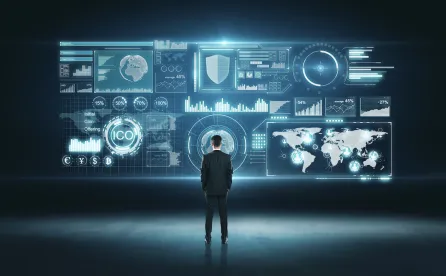As technology marches forward, even the most established of industries are grappling with innovative new ways to track and utilize data and artificial intelligence. We recently spoke with several experts and thought leaders to gain insights into the areas our clients should be monitoring, because they could present opportunity and challenge for business—leading to swells in intellectual property or other disputes.
The adoption of Artificial Intelligence (AI) into business process or commercial applications has grown in recent years. Even in long-enduring industries like healthcare, leaders are facing entirely new challenges.
Dr. Bill Bysinger is an IMS Elite Expert and thought leader in our network who specializes in healthcare software, data, and technology. He notes that “AI in Healthcare provides the amazing ability to interpret large quantities of patient health data. However, it is very human agnostic.” Dr. Bysinger continues, “Over time this could cause issues from too much reliance on AI-generated data for treatment and diagnosis.”
Bysinger suggests careful consideration related to technical integration. Disputes could arise in scenarios where industry leaders aren’t informed enough to make decisions with all necessary context. “Healthcare Software Patent litigation may be harder in the future due to the absence of good software engineering discipline around specifications and documentation,” mentions Bysinger. “New technologies, especially those deployed exclusively on Handheld devices and the Internet do not have the same discipline and rigor as larger scale systems that used to be used for like applications.”
Meanwhile, the coming five years for the aerospace industry will likely continue to grow reliance on data for aerospace vehicles. Dr. Magdy Attia, is an expert in our network, named inventor on three U.S. patents, and recipient of the prestigious George Westinghouse Signature Award of Excellence. Attia, who also serves as Professor and Associate Chair of Embry Riddle Aeronautical University’s Department of Aerospace Engineering, observes, “The airplane is really no longer an airplane; it’s a flying computer. The engine is not really an engine; it’s a computer that produces thrust. There are computers in everything doing almost all of the functions, controlling the flight vehicle, engine, and everything inside.”
With data integration taking flight throughout the industry, software and computer engineering are increasingly becoming requisite for aerospace engineering.
Following the retirement of NASA’s Shuttle Program, the U.S. has seen massive investment growth in private space launch ventures such as SpaceX, Blue Origin, and Virgin Galactic. This pivot from publicly-funded space exploration and R&D could present challenges and opportunity for business and economies. Observing that the private sector can move with greater urgency and market-responsiveness than public agencies, Attia says, “They have been able to come up with some very innovative techniques and have really filled in the gap that the Shuttle program left open.”
For attorneys, the space sector’s new generation invites questions. “When these companies become multinational, all of a sudden you don’t have control of the technology that you once had,” explains Attia. “I think we as a nation, we as experts, need to continue to pay attention to that. Who owns the technology? Where is it being developed? Where is it going? And, that’s really the important question.”
The next two to five years may prove to be interesting for IP and complex litigation. Attia observes, “We’re seeing the reintroduction of old ideas as new ideas.” He explains that many concepts designed by very bright engineers years or decades earlier could now finally be ready to test or commercialize. “Maybe they did not have the capacity to see it through or build it. Maybe the material wasn’t there, maybe the supporting technology wasn’t there.” As old becomes “new”, Attia advises, “That is going to lead to some very interesting intellectual property discussions.”




 />i
/>i